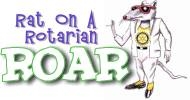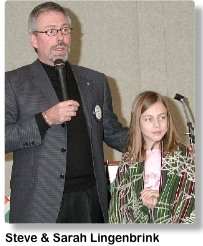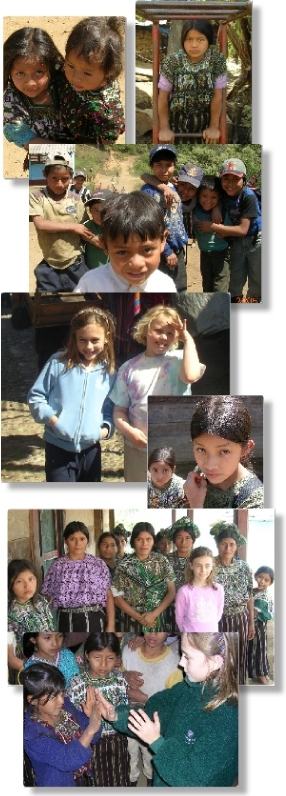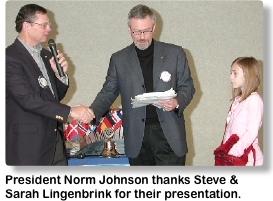|
||||||||||
 |
|||||||||||||||||||||
|
Vol. 17, No. 39, March 28, 2005 IN THIS ISSUE: This Reveille Home Page | The Friday Program: A Return to the Village of Xeucalvitz | District Conference Seeks Attendees | We Get Emails | We Get Thanks | Friday Potpourri | Announcements | Scholarship Recipient Gives Update | Classification Talk: Rodd Kippen | Web Fun |
|||||||||||||||||||||
|
|||||||||||||||||||||
|
The Friday Program:
(1) To revisit the village that Steve and Terri Lingenbrink had become the “champions” of in 2003 to raise the funds necessary to purchase land and rebuild the entire village. (2) To complete a road up to the village. (3) To plan for the future water project and education project components of the Village. During their trip they spent two days getting to the village, six days in the village and then a few additional days in Guatemala “decompressing” before returning. The trip was a success. This was the first group that had ever stayed overnight in the village. During their stay the villagers and the team gradually grew close and began interacting both at a work and recreational level. The girls taught the children hand games, jump rope, games like “duck-duck-goose” and basic English words. They also worked side by side with their dads and the villagers on the road project.
Steve, who assumes the presidency of the BBRC on July 1, said he was “stunned by a presentation from World Vision at the recent PETS conference. The Object of Rotary — the 4th Object — says ‘The advancement of international understanding, goodwill, and peace through a world fellowship of business and professional persons united in the ideal of service.’ All of the new Presidents-elect at PETS got a letter from World Vision, proposing forming a partnership, an alliance, with other organizations. This would be a pilot for Rotary International, officially recognizing that there’s more bang for buck with collaboration. Our work with Agros would fit nicely into this proposal.” Steve and Curt were guests of the four Guatemala City Rotary Clubs. They spoke at three special meetings one morning and then at a lunch meeting of the club meeting that day. All of the Rotary Clubs were enthusiastic for the project and pledged their continued support. The major long-term project for the village is the water project. Over a year ago, Lingenbrink began the process of rounding up financial support from the BBRC, other Rotary Clubs (Guatemala), District 5030 and individual donors. This amount was then matched by Rotary International, making a total of $19,000 committed to this project. The check was passed on to Agros a few weeks ago, assuring that the project will go forward. The water project intends to provide service to homes in the village, as well as to the crops that will be planted on the newly-acquired land. For the first time, the villagers will have the luxury of running water in their homes. The visitors spent each day working to improve the road to the village. This would also be a long-term project. “So, now there’s a road to village (sort of),” said Steve. “We enjoyed watching our kids interact with the kids of the village. Kids are kids no matter what the language.” Sarah Lingenbrink was asked to explain how they communicated. “We taught our new friends hand games to communicate. We attended their school and played together. Their kids wore woven clothing, wearing the same outfit every day. We taught them such games as Duck-Duck-Goose, which in their Mayan dialect is Pato Pato Gonzo! We also jumped rope, and played with Frisbees.” Sarah shared a large handful of pictures drawn by the school children, showing their homes and village from their point of view. She was also wearing a beautiful woven blanket given as a gift. Steve further reported that the village children had never seen a motorized vehicle until the four-wheel drive made it up the mountain. “They chased the trucks as they entered the village.” Lingenbrink commented that children were not in the best of health because their diet lacks balance. “One of the important stories of Xeucalvitz is how improving the transportation and water systems will bring nourishment and health to the children.”
Community Organization & Leadership help families define a vision for a new community, and develop the local leadership required to create a sustaining, thriving community. Land Ownership Work with community to identify and purchase agricultural land on credit and use their payments to purchase land for other new communities. Housing & Infrastructure Implement community and individual construction projects such as houses, schools, irrigation systems, latrines, infrastructure and community centers. Sustainable Economic Growth Develop agricultural production and support income-generating activities through microenterprise loans and technical training. Community Education & Training Create opportunities for adequate healthcare, education, adult literacy, and spiritual growth. Deana said the model counts on the community to decide the course of action. She thanked the BBRC for its involvement. Agros works to collaborate with other non-governmental organizations to bring projects to villages such as Xeucalvitz. “We still have a way to go to make this village a full Agros partner. Only 20% of the funding is secure. The model calls for 80% of the funding to be in place before the village qualifies as an Agros village. “Agros focuses on land ownership because owning land is one of the most effective ways for the rural poor to escape the entrapment of poverty. Seventeen different Rotary Clubs have partnered with Agros in these life-changing projects. It’s all about the land ... buying the land, giving the villagers agricultural training, clean water, schools, healthcare, and the sale of their newly-planted crops will payoff the land purchase. There are many possibilities for involvement by individuals and groups. That’s what makes the Agros model so powerful” Gregory said.
Curt and Steve received a certificate thanking them for their presentation and noting that 1220 pounds of fresh produce has been donated to area food banks from Rotary First Harvest. Thanks to Steve Lingenbrink and Curt Cummings for their project and to President Norm for his introduction. |
|||||||||||||||||||||
 |
|||||||||||||||||||||
|
CLICK HERE |
|||||||||||||||||||||
|
Reveille | Reveille Archives | Meeting Information | Calendar | How to Join the BBRC | Officers & Directors | Committees | Online Member Directory | Short Directory PDF File | Directory Info Form | Set Up User Info | Forgot User Info | Meeting Make-Up Form | Attendance Statistics | New Member Application (PDF File) | Expense-Funding Request Form (PDF File) | Rotary Foundation Pledge Form | District 5030 Website & Newsletter | 2004 Raffle Winner | About the Raffle | Email Us DISTRICT 5030 CLUB INFORMATION |
|||||||||||||||||||||




